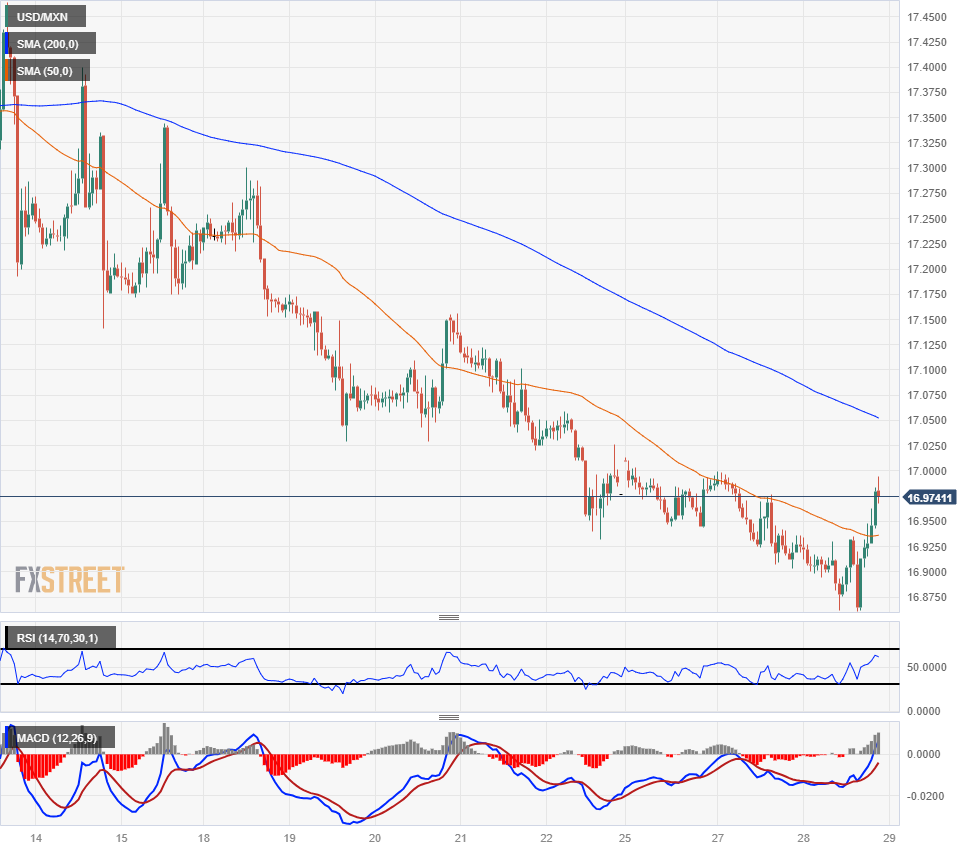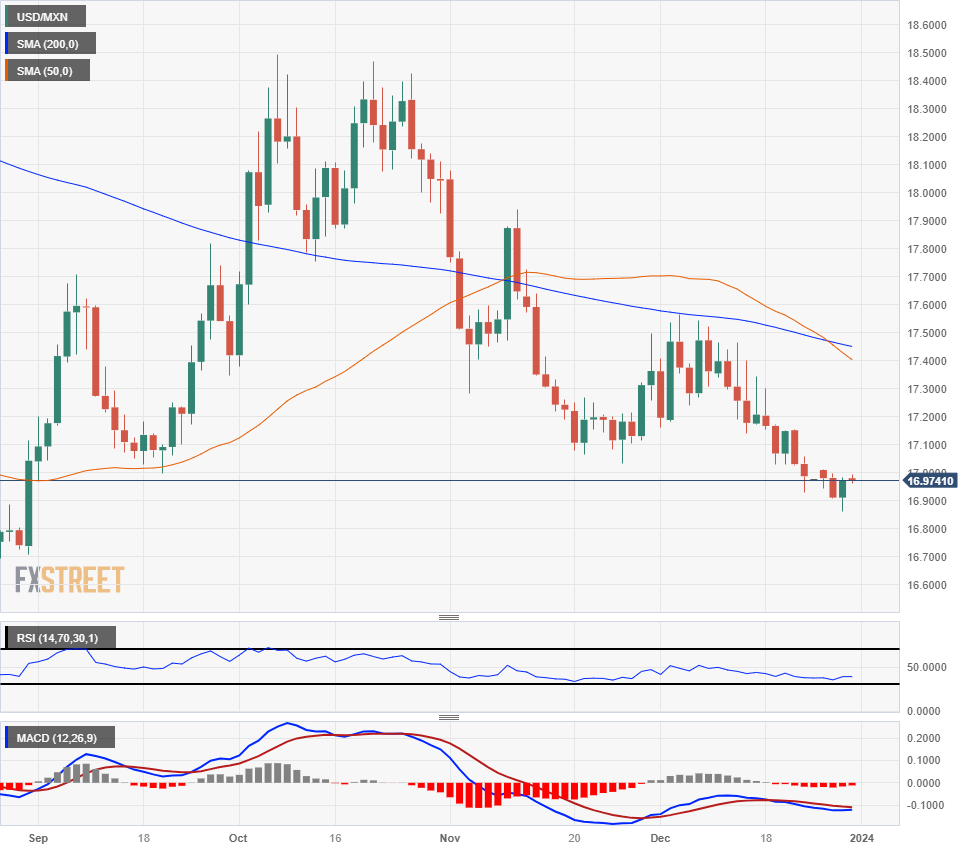The Mexican Peso gains further ground as the US Dollar selloff continues.
Mexico’s Jobless Rate stays unchanged in November, US Jobless Claims climbed last week.
Coming up on Friday: US Chicago PMI, Mexico Fiscal Balance.
The Mexican Peso (MXN) continued to climb through the penultimate trading day of 2023 before falling once more as broad-market US Dollar flows dictate the general direction of the FX market. A thin trading week between two market holidays is seeing some rough chop as speculators churn USD flows in thin market volumes to round out the 2023 trading year.
Despite a late topside break for the USD, the MXN is poised for a third straight week of gains against the US Dollar as the Greenback faces broad-market selling pressure.
Mexico’s unadjusted Jobless Rate held steady in November, thumbing its nose at market expectations of a minor decline, though the seasonally adjusted figure ticked higher. On the US side, Initial Jobless Claims and Pending Home Sales both missed expectations to come in worse than expected. With US data softening at the print, bad news is good news in topsy-turvy markets that are looking for accelerated rate cuts from the Federal Reserve (Fed).
Daily digest market movers: Mexican Peso hits fresh 16-week as Greenback continues to backslide
The Mexican Peso is up around 0.3% against the US Dollar on Thursday, gaining 0.8% from the week’s opening bids.
Broad-market USD selling pressure is bolstering the Peso, with the US Dollar the single worst-performing of the majors, in the red across the board for the last trading week of the year.
Mexico’s unadjusted Jobless Rate held steady at 2.7% in November versus the forecast tickdown to 2.6%, though the seasonally-adjusted figure showed a slight jump to 2.8%.
US Initial Jobless Claims jumped to 218K for the week ended December 22, vaulting over the forecast 210K and pushing even higher from the previous week’s 206K (revised upwards from 205K).
US Pending Home Sales in November also failed to recover as much ground as forecasts expected, printing at a flat 0.0% compared to a forecast 1.0% gain; October’s print of -1.2% was revised slightly upwards from -1.5%.
Friday will round out the 2023 trading year with the US Chicago Purchasing Managers’ Index for December, forecast to decline from 55.8 to 51.0.
Mexico’s Fiscal Balance in Peso terms for November will wrap up the year’s economic data prints from Mexico. The Secretaría de Hacienda y Crédito Público, Mexico’s finance ministry, last printed a MXN 29.58 billion deficit in October.
US Dollar price this week
The table below shows the percentage change of US Dollar (USD) against listed major currencies this week. US Dollar was the strongest against the Pound Sterling.
USD
EUR
GBP
CAD
AUD
JPY
NZD
CHF
USD
-0.35%
-0.09%
-0.36%
-0.57%
-0.75%
-0.64%
-1.68%
EUR
0.43%
0.27%
0.11%
-0.15%
-0.39%
-0.21%
-1.25%
GBP
0.22%
-0.35%
0.00%
-0.47%
-0.69%
-0.37%
-1.74%
CAD
0.36%
-0.30%
0.21%
-0.47%
-0.40%
-0.12%
-1.47%
AUD
0.57%
0.15%
0.47%
0.21%
-0.22%
-0.02%
-1.29%
JPY
0.75%
0.43%
0.48%
0.68%
0.21%
0.31%
-1.09%
NZD
0.64%
0.23%
0.57%
0.28%
0.03%
-0.19%
-1.00%
CHF
1.84%
1.21%
1.40%
1.46%
1.33%
1.07%
1.06%
The heat map shows percentage changes of major currencies against each other. The base currency is picked from the left column, while the quote currency is picked from the top row. For example, if you pick the Euro from the left column and move along the horizontal line to the Japanese Yen, the percentage change displayed in the box will represent EUR (base)/JPY (quote).
Technical Analysis: Mexican Peso stretching for further gains to wrap up the year, USD/MXN sinks in rough trading
The Mexican Peso (MXN) climbed to a fresh 16-week high against the US Dollar on Thursday, sending the USD/MXN to a multi-month low of 16.86. The pair has steadily declined through the shortened trading week and fell nearly a full percent peak-to-trough before a broad-market rebound in the US Dollar across the broader market space.
The USD/MXN is poised to close in the red for the third straight week and is set to close December in the red as well, rounding out one of the US Dollar’s worst-performing years against the Peso to date, closing lower for 9 of the past 12 straight months.
Ongoing selling pressure has brought the USD/MXN within multi-year lows near 16.60, and a break below this level would mark the pair’s weakest bids since December 2015.
On the high side, the 200-day Simple Moving Average (SMA) is parked near 17.45, and the bearish cross of the 50-day SMA is chalking in a long-term resistance barrier to cap off any bullish reversals.
USD/MXN Hourly Chart

USD/MXN Daily Chart

Mexican Peso FAQs
The Mexican Peso (MXN) is the most traded currency among its Latin American peers. Its value is broadly determined by the performance of the Mexican economy, the country’s central bank’s policy, the amount of foreign investment in the country and even the levels of remittances sent by Mexicans who live abroad, particularly in the United States. Geopolitical trends can also move MXN: for example, the process of nearshoring – or the decision by some firms to relocate manufacturing capacity and supply chains closer to their home countries – is also seen as a catalyst for the Mexican currency as the country is considered a key manufacturing hub in the American continent. Another catalyst for MXN is Oil prices as Mexico is a key exporter of the commodity.
The main objective of Mexico’s central bank, also known as Banxico, is to maintain inflation at low and stable levels (at or close to its target of 3%, the midpoint in a tolerance band of between 2% and 4%). To this end, the bank sets an appropriate level of interest rates. When inflation is too high, Banxico will attempt to tame it by raising interest rates, making it more expensive for households and businesses to borrow money, thus cooling demand and the overall economy. Higher interest rates are generally positive for the Mexican Peso (MXN) as they lead to higher yields, making the country a more attractive place for investors. On the contrary, lower interest rates tend to weaken MXN.
Macroeconomic data releases are key to assess the state of the economy and can have an impact on the Mexican Peso (MXN) valuation. A strong Mexican economy, based on high economic growth, low unemployment and high confidence is good for MXN. Not only does it attract more foreign investment but it may encourage the Bank of Mexico (Banxico) to increase interest rates, particularly if this strength comes together with elevated inflation. However, if economic data is weak, MXN is likely to depreciate.
As an emerging-market currency, the Mexican Peso (MXN) tends to strive during risk-on periods, or when investors perceive that broader market risks are low and thus are eager to engage with investments that carry a higher risk. Conversely, MXN tends to weaken at times of market turbulence or economic uncertainty as investors tend to sell higher-risk assets and flee to the more-stable safe havens.
Information on these pages contains forward-looking statements that involve risks and uncertainties. Markets and instruments profiled on this page are for informational purposes only and should not in any way come across as a recommendation to buy or sell in these assets. You should do your own thorough research before making any investment decisions. FXStreet does not in any way guarantee that this information is free from mistakes, errors, or material misstatements. It also does not guarantee that this information is of a timely nature. Investing in Open Markets involves a great deal of risk, including the loss of all or a portion of your investment, as well as emotional distress. All risks, losses and costs associated with investing, including total loss of principal, are your responsibility. The views and opinions expressed in this article are those of the authors and do not necessarily reflect the official policy or position of FXStreet nor its advertisers. The author will not be held responsible for information that is found at the end of links posted on this page.
If not otherwise explicitly mentioned in the body of the article, at the time of writing, the author has no position in any stock mentioned in this article and no business relationship with any company mentioned. The author has not received compensation for writing this article, other than from FXStreet.
FXStreet and the author do not provide personalized recommendations. The author makes no representations as to the accuracy, completeness, or suitability of this information. FXStreet and the author will not be liable for any errors, omissions or any losses, injuries or damages arising from this information and its display or use. Errors and omissions excepted.
The author and FXStreet are not registered investment advisors and nothing in this article is intended to be investment advice.
>>> Read full article>>>
Copyright for syndicated content belongs to the linked Source : FXStreet – https://www.fxstreet.com/news/mexican-peso-continues-to-climb-into-2023-finish-line-202312281654















![[News] Japan Develops 10nm Nanoimprint Technology, with Potential to Tackle EUV Bottleneck – TrendForce](https://earth-news.info/wp-content/uploads/2025/12/329851-news-japan-develops-10nm-nanoimprint-technology-with-potential-to-tackle-euv-bottleneck-trendforce-360x180.jpg)















